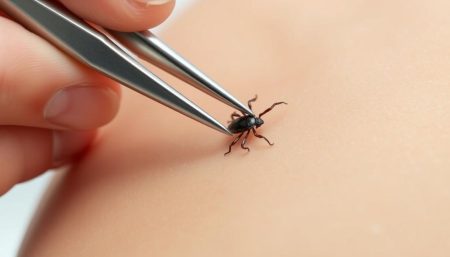Scrotal swelling can be a sign of a hydrocele, a condition where fluid builds up around the testicle. When this becomes problematic, hydrocele surgery, also known as hydrocelectomy, may be necessary. This procedure aims to drain the excess fluid and prevent its recurrence.
Hydrocele surgery is a common urological procedure that can provide relief from discomfort and prevent complications. The treatment involves removing the fluid-filled sac, allowing for proper healing and restoration of normal testicular function.
Recovery from hydrocelectomy typically takes a few weeks, during which patients must follow specific care instructions. The benefits of this surgery include reduced swelling, improved comfort, and a decreased risk of future complications.
Understanding Hydrocele: Causes and Symptoms
A hydrocele is a condition that affects male reproductive health. It causes testicular fluid buildup. This swelling can happen in one or both testicles, leading to discomfort and concern for many men.
Common Causes of Testicular Fluid Buildup
Testicular fluid buildup can come from different reasons. In newborns, it’s often because the processus vaginalis didn’t close fully during fetal development. For adults, causes might include injury, infection, or inflammation in the scrotum or testicles.
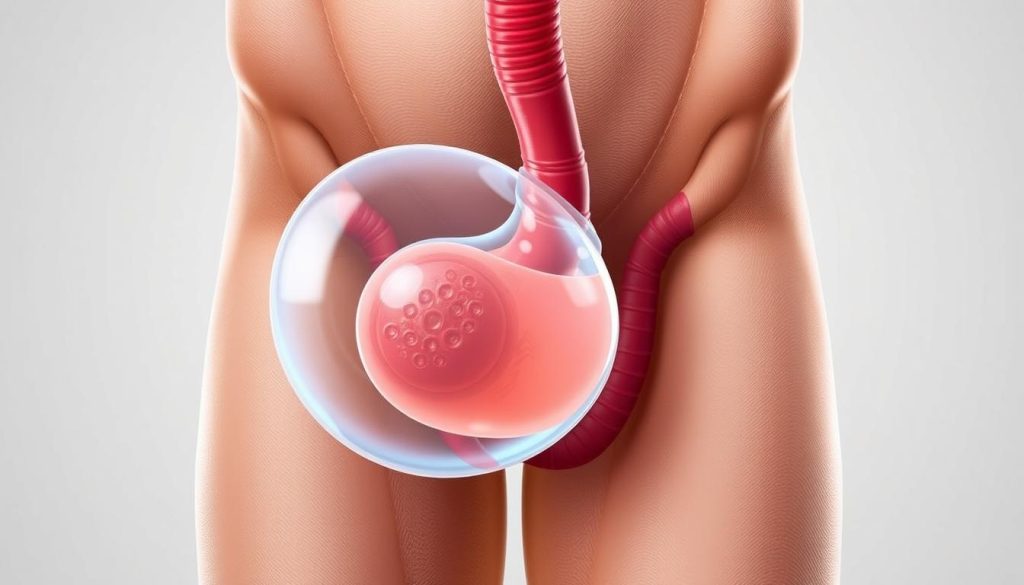
Identifying Hydrocele Symptoms
Key symptoms of hydrocele include:
- Painless swelling in the scrotum
- Feeling of heaviness in the affected area
- Discomfort during physical activities
- Visible enlargement of the scrotum
Risk Factors and Prevalence
Hydrocele can affect men of all ages but is most common in newborns and older men. Risk factors include:
| Age Group | Risk Factor | Prevalence |
|---|---|---|
| Newborns | Developmental issues | 10% of male infants |
| Adult men | Scrotal injury or infection | 1% of adult males |
| Older men (50+) | Age-related changes | Up to 5% of men over 50 |
Understanding hydrocele is key for keeping male reproductive health in check. It’s important to seek medical attention when symptoms appear.
When Medical Intervention Becomes Necessary
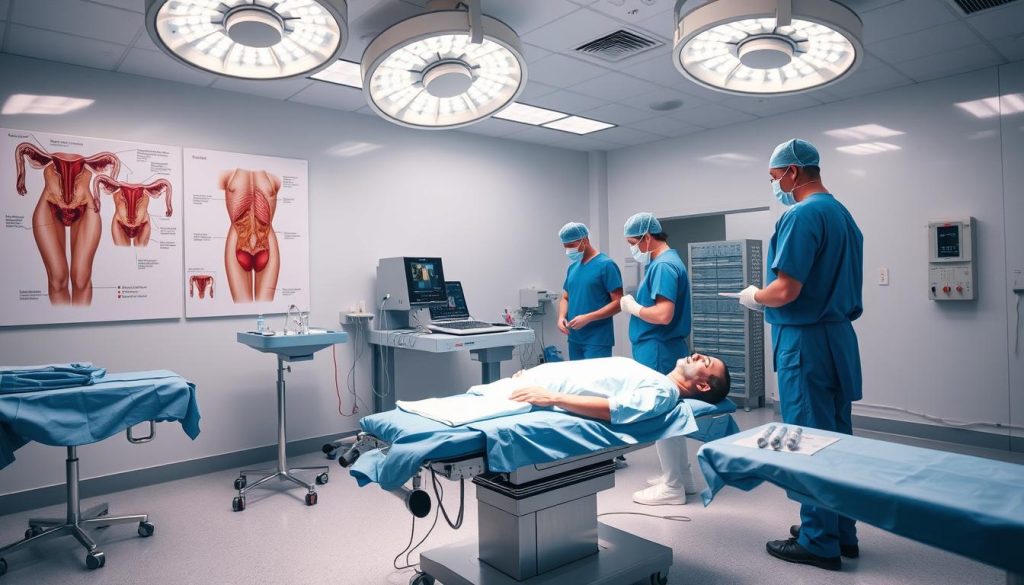
Hydrocele often goes away on its own. But sometimes, urological procedures are needed. Doctors look at many factors before suggesting surgery.
Size is important for hydroceles. A big swelling can be uncomfortable and get in the way of daily life. If it gets too big, surgery might be necessary.
Pain is also a key sign. Most hydroceles don’t hurt, but some men feel aching or heaviness. If the pain doesn’t go away, it’s time to see a doctor.
How it affects your life is also important. If it makes moving, sleeping, or being intimate hard, surgery might help.
“When a hydrocele persists or grows, it’s time to consider surgical options. We aim to improve the patient’s comfort and prevent possible complications.”
Ignoring a hydrocele can lead to problems. These might include:
- Infection
- Rupture
- Pressure on nearby tissues
Also, a hydrocele might hide other testicular issues. Surgery can find and treat these problems.
The choice to have surgery is made together. The patient and their urologist consider health and well-being.
Types of Hydrocele Surgery Procedures
Hydrocele surgery is a common treatment for fluid buildup around the testicles. Different techniques are used, each with its own benefits and considerations.
Traditional Open Surgery
Open surgery is a well-known method for treating hydrocele. The surgeon makes a cut in the scrotum or lower abdomen to remove the fluid sac. This approach is often chosen for complex cases because it allows for direct viewing of the area.
Laparoscopic Techniques
Laparoscopic surgery is a less invasive option. It involves small cuts for a camera and tools. This method usually means faster healing and less pain compared to open surgery.
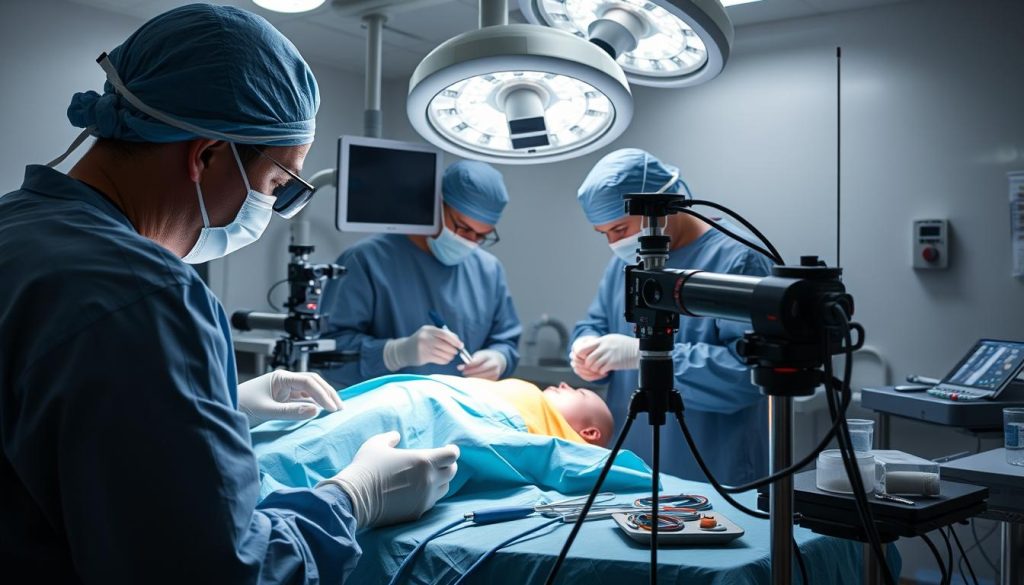
Microsurgical Approaches
Microsurgical repair uses high-powered microscopes for detailed work. It’s great for delicate cases and can lead to fewer complications and better results.
| Procedure | Incision Size | Recovery Time | Best For |
|---|---|---|---|
| Open Surgery | 2-3 inches | 2-4 weeks | Complex cases |
| Laparoscopic | 0.5-1 inch | 1-2 weeks | Quicker recovery |
| Microsurgical | 1-2 inches | 1-3 weeks | Precision work |
The choice of surgery depends on the hydrocele size, patient health, and surgeon skill. Talking to a urologist can help find the best option for each case.
Preparing for Hydrocele Surgery
Getting ready for a hydrocelectomy needs careful planning. Your doctor will give you specific instructions. This ensures a smooth procedure and recovery. Here’s what you need to know before your surgery.
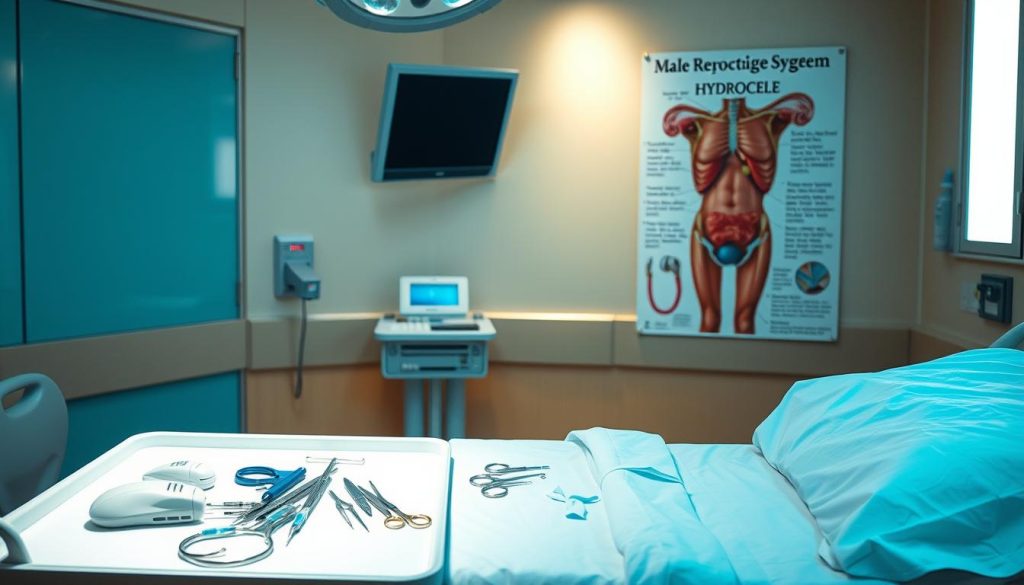
Your doctor may order blood tests or imaging studies. These tests check your overall health. They help find any complications that could affect your surgery.
You’ll need to adjust your medication routine. Stop taking blood thinners and certain supplements a week before the surgery. Your doctor will give you a list of medications to avoid.
- Fast for 8-12 hours before surgery
- Arrange for someone to drive you home
- Wear loose, comfortable clothing
- Pack essential items for your hospital stay
On the day of your hydrocelectomy, shower with antibacterial soap. This reduces infection risk. Remove all jewelry and leave valuables at home.
| Items to Bring | Items to Leave at Home |
|---|---|
| Insurance card | Jewelry |
| ID | Contact lenses |
| Comfortable clothes | Valuables |
| List of medications | Large amounts of cash |
By following these guidelines, you’ll be well-prepared for your hydrocelectomy. Remember to discuss any concerns with your surgeon before the procedure.
The Surgical Process Step by Step
Hydrocele surgery is a common urological procedure. It needs careful planning and execution. Knowing the steps can make patients feel more at ease. Let’s explore the process of this important treatment.
Anesthesia Administration
The first step is giving anesthesia. Doctors might use local, regional, or general anesthesia. This choice affects how you’ll feel during the surgery and how long it takes to recover.
Surgical Incision and Procedure
After anesthesia, the surgeon makes a small incision. This can be in the scrotum or lower abdomen. They find the hydrocele sac and separate it from other tissues.
Then, they drain the fluid and remove or reposition the sac. This stops future fluid buildup.
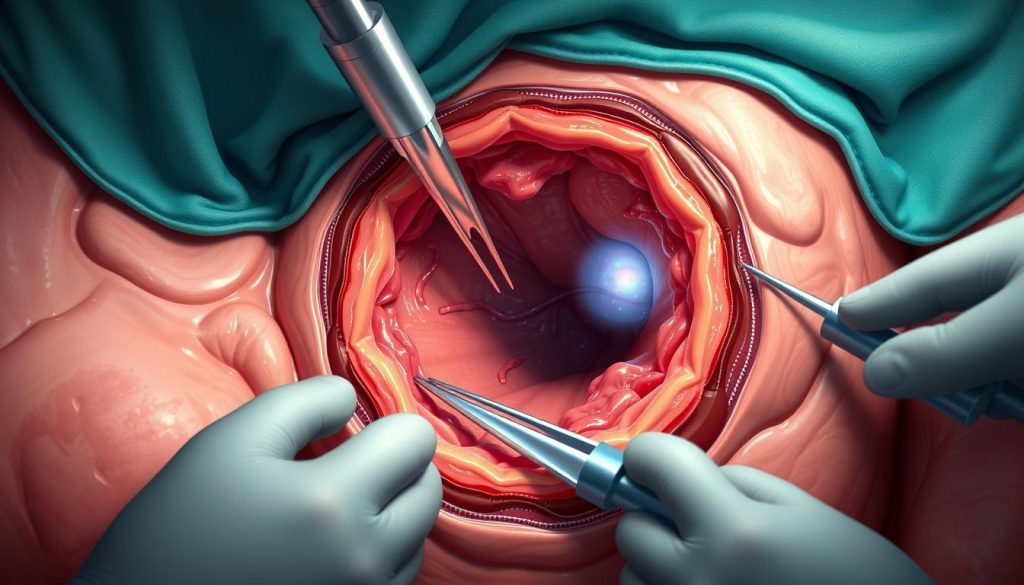
Closing and Immediate Post-Op Care
After fixing the hydrocele, the surgeon closes the incision with dissolvable stitches. A sterile dressing is applied to protect the area. Right after, you’ll be monitored and pain managed as you wake up.
| Surgery Stage | Duration | Key Actions |
|---|---|---|
| Anesthesia | 15-30 minutes | Administer chosen anesthetic |
| Incision & Procedure | 30-60 minutes | Make incision, drain fluid, remove sac |
| Closing & Post-Op | 20-40 minutes | Close incision, apply dressing, monitor patient |
This overview helps patients understand hydrocele surgery better. Each step is important for a good outcome and easy recovery.
Post-Operative Recovery Timeline
After a hydrocelectomy, patients start a healing journey important for male health. Knowing this timeline helps set realistic goals and ensures healing goes well.
The first days after surgery are critical. Patients are watched closely in the hospital. They might feel pain and swelling, but these can be managed with medicine. Most can go home within a day, unless there are issues.
At home, the first week is all about rest. Avoiding hard work and following the doctor’s wound care advice is key. Ice packs can also help with swelling and pain.
By weeks 2-4, things start to get better. You can start doing light things again, but no heavy lifting. Regular check-ups with your doctor are important to see how you’re healing.
By 4-6 weeks after surgery, you should be fully recovered. You can then start doing regular activities, like exercising and having sex, with your doctor’s okay.
| Recovery Stage | Duration | Key Points |
|---|---|---|
| Hospital Stay | 1-2 days | Pain management, monitoring |
| Initial Home Recovery | 1 week | Rest, wound care, ice application |
| Gradual Improvement | 2-4 weeks | Light activities, follow-up visits |
| Full Recovery | 4-6 weeks | Return to normal activities |
Keep in mind, everyone heals at their own pace. Always talk to your healthcare provider for advice tailored to you during your recovery from hydrocelectomy.
Managing Pain and Discomfort After Surgery
After hydrocele surgery, you might feel scrotal swelling and discomfort. It’s important to manage pain well for a smooth recovery. Let’s look at ways to lessen pain and help your body heal.
Medication Options
Pain relief meds are key for feeling better after surgery. Your doctor might suggest:
- Over-the-counter pain relievers (acetaminophen, ibuprofen)
- Prescription pain meds for more severe pain
- Anti-inflammatory drugs to cut down swelling
Make sure to follow your doctor’s advice on how much to take and when.
Physical Support Methods
Reducing strain on the surgery area can help with pain. Try these methods:
- Wear supportive underwear or a jockstrap
- Apply ice packs to lessen swelling (15 minutes on, 15 minutes off)
- Use a small pillow to lift the scrotum while lying down
Activity Restrictions
To avoid problems and manage pain, limit certain activities:
- Avoid heavy lifting for 2-4 weeks
- Stay away from hard exercise for 3-4 weeks
- Take short walks to keep blood flowing
- Slowly start doing more as your doctor says
| Recovery Phase | Pain Level | Recommended Actions |
|---|---|---|
| Days 1-3 | Moderate to High | Rest, ice, medication |
| Days 4-7 | Mild to Moderate | Gentle movement, continued support |
| Weeks 2-4 | Mild | Gradual return to normal activities |
Potential Complications and Risk Factors
Hydrocelectomy is a common surgery, but it’s important to know the risks. Complications are rare, but they can happen. This is more likely if the surgeon doesn’t have much experience.
Infection is a big worry after surgery. Look out for redness, swelling, or discharge at the cut. If you get a fever, see a doctor right away.
Bleeding is another risk. You might see bruising or a bit of bleeding. But if it’s a lot, you need to see a doctor fast.
Some people might need the surgery again because the hydrocele comes back. This can happen if the surgery didn’t get all of it. Other reasons include:
- Large hydrocele size
- Incomplete removal of the hydrocele sac
- Underlying medical conditions
Chronic pain is rare but can happen. It might make everyday tasks hard. In some cases, nerves or blood vessels can get hurt during the surgery.
Following your doctor’s instructions after surgery is key. Regular check-ups with your urologist are also important. They help make sure you’re healing right and catch any problems early.
Long-term Benefits of Hydrocele Treatment
Hydrocele surgery greatly improves male reproductive health in the long run. It makes life better for those who get it done. The surgery removes extra fluid from the scrotum, easing pain and lowering the chance of future problems.
One big plus is feeling more comfortable physically. Men no longer have to deal with swelling and heaviness. This means they can move around easily and do things they love without pain.
Looking good is another benefit. The surgery makes the scrotum look normal again. This can make men feel better about themselves, which helps their relationships and overall happiness.
- Improved comfort and mobility
- Enhanced aesthetic appearance
- Reduced risk of complications
- Increased self-confidence
For men’s reproductive health, treating a hydrocele is key. It stops problems that could hurt fertility. This helps keep reproductive health strong for the future.
Men say their sex lives get better after surgery. Without the hydrocele, they can enjoy intimate moments more. This is because they’re no longer limited by the condition.
“After my hydrocele surgery, I felt like a new man. The discomfort was gone, and I could enjoy life without constantly worrying about my condition.”
Studies show the benefits of hydrocele surgery last a long time. Most patients stay symptom-free for years. This proves it’s a lasting fix for this common issue.
Alternative Treatment Options
Hydrocele surgery is often needed for serious cases. But, there are other ways to handle testicular fluid buildup. These might be good for those with mild symptoms or who don’t want surgery.
Non-Surgical Interventions
Some treatments don’t need surgery. Aspiration uses a needle to drain fluid, giving quick relief. Sclerotherapy injects a solution to stop fluid buildup, lasting longer. These options are less invasive but might need to be done again.
Watchful Waiting Approach
For small, painless hydroceles, doctors might suggest waiting and watching. This means keeping an eye on the condition without acting right away. Patients should watch for size changes and discomfort, telling their doctor about it.
If the hydrocele stays the same or gets better on its own, this method can avoid surgery. It’s a careful way to handle the situation.
- Monitor size and symptoms regularly
- Report changes to your doctor
- Schedule follow-up appointments as advised
Deciding between treatments and surgery depends on many things. This includes how bad the fluid buildup is, what you prefer, and your health. Talk to a urologist to find the best option for you.
Cost Considerations and Insurance Coverage
Understanding the financial side of hydrocelectomy is key for those thinking about it. The cost of this surgery can change a lot. It depends on where you are, the hospital fees, and the surgeon’s experience.
Usually, hydrocelectomy costs between $4,000 and $6,000 without insurance. This price includes the surgeon’s fee, anesthesia, and the hospital’s charges. If you have insurance, your costs might be lower. But, how much depends on your insurance plan.
To get ready financially for hydrocele surgery:
- Contact your insurance provider to check if they cover urological procedures
- Ask your healthcare provider for a detailed cost breakdown
- Find out about payment plans or financial help
- Look into getting a second opinion to compare prices
While cost matters, the quality of care is more important. Talk to your healthcare team about any financial worries. This way, you’ll be ready for this important surgery.
Choosing the Right Surgeon
Finding a skilled surgeon is key for a successful hydrocele surgery. Patients must look at several factors to get the best care for their urological needs.
Qualifications to Look For
When looking for a surgeon for hydrocele surgery, focus on these qualifications:
- Board certification in urology
- Extensive experience in urological procedures
- Fellowship training in male reproductive health
- Positive patient reviews and outcomes
- Affiliation with reputable medical institutions
Questions to Ask Your Provider
Get ready for your consultation by asking these key questions:
| Question | Why It’s Important |
|---|---|
| How many hydrocele surgeries have you performed? | Assesses experience level |
| What’s your success rate for this procedure? | Indicates overall outcomes |
| Which surgical technique do you recommend for my case? | Reveals personalized approach |
| What are the possible complications? | Provides insight into risks |
| How long is the expected recovery time? | Helps plan post-surgery care |
By carefully checking qualifications and asking the right questions, patients can make smart choices for their hydrocele surgery. They can pick a surgeon who fits their needs best.
Recovery Tips and Lifestyle Modifications
After a hydrocelectomy, it’s important to recover well for your male reproductive health. Always follow your surgeon’s advice to heal right and avoid problems.
Wound care is a must. Keep the incision clean and dry. Use mild soap and water to clean it, then dry it gently. Don’t take baths, swim, or use hot tubs until your doctor says it’s okay.
Rest is important in the early recovery days. Start moving more as your doctor tells you to. Walking a bit can help your blood flow and prevent clots.
- Wear supportive underwear or a scrotal support to reduce swelling and discomfort
- Apply ice packs to the affected area to manage pain and swelling
- Take prescribed pain medications as directed
- Avoid heavy lifting and strenuous activities for at least 2-4 weeks
Good nutrition is key for healing. Eat foods full of protein, vitamins, and minerals. Drink lots of water to stay hydrated. Avoid alcohol and smoking because they slow healing.
Wait to start sexual activity until your doctor says it’s safe, usually after 2-4 weeks. Use protection to prevent infections while you’re healing.
By sticking to these tips, you can have a smooth recovery and keep your male reproductive health in good shape after hydrocelectomy.
Follow-up Care and Monitoring
After hydrocele surgery, it’s key to follow up properly. Patients must watch their healing closely and keep their doctor’s appointments.
Post-Surgery Appointments
Your surgeon will book several follow-ups to check on you. These visits are for wound checks, stitch removal, and to talk about any issues.
| Appointment | Timing | Purpose |
|---|---|---|
| First Follow-up | 1 week post-surgery | Wound check, pain assessment |
| Second Follow-up | 2-3 weeks post-surgery | Stitch removal, activity clearance |
| Final Follow-up | 6-8 weeks post-surgery | Full recovery evaluation |
Signs of Proper Healing
Knowing when you’re healing right is important. Look for:
- Swelling going down
- Pain getting less
- Incision site looking less red
- No weird discharge or smell
When to Seek Medical Attention
Even though problems are rare, knowing when to call your doctor is key. Get help fast if you have:
- Fever over 101°F (38.3°C)
- More pain or swelling
- Bleeding or pus from the cut
- Trouble peeing
By sticking to your doctor’s advice and going to all follow-ups, you’ll heal well. You’ll get back to your usual life fast.
Impact on Fertility and Sexual Health
Many men worry about hydrocele and its treatment affecting their fertility and sex life. The good news is that hydrocele and its treatment usually don’t harm fertility or sex function.
Hydrocele itself rarely affects sperm production or testosterone levels. The fluid buildup happens outside the testicle, leaving the inside parts working as usual. This means the testicles can keep making sperm and hormones normally.
When it comes to surgery, modern methods aim to keep fertility safe. Surgeons are very careful not to harm the parts involved in making sperm. Most men can start having sex again a few weeks after surgery, once they’re fully healed.
“In my experience, patients often return to normal sexual function quickly after hydrocele surgery, with no long-term effects on their reproductive capabilities,” says Dr. Sarah Johnson, a urologist specializing in male reproductive health.
Even though complications are rare, it’s important to talk to your doctor before and after surgery. They can give advice based on your situation and help ensure the best results for your reproductive health.
| Aspect | Impact of Hydrocele | Impact of Surgery |
|---|---|---|
| Fertility | Minimal to none | Typically no long-term effects |
| Sexual Function | May cause discomfort | Temporary abstinence during recovery |
| Hormone Production | Not affected | No impact |
Latest Advancements in Hydrocele Surgery
The field of hydrocele surgery has made big strides in recent years. New techniques are making urological procedures better for patients. Now, surgeons use methods that make recovery faster and less painful.
High-definition imaging is a big leap forward in hydrocele surgery. It lets doctors see the affected area very clearly. This leads to more accurate treatments. Laser-assisted techniques are also being used, giving doctors more control and possibly fewer complications.
How we care for patients after surgery has also changed. New pain management and special dressings help patients heal faster. Now, patients get recovery plans that fit their needs and lifestyle.
Looking ahead, the future of treating hydrocele is exciting. Scientists are working on regenerative medicine that could change urological procedures. These new ideas aim to make the whole process better, from diagnosis to recovery.
FAQ
Q: What is a hydrocele?
A: A hydrocele is when fluid builds up in the scrotum, causing swelling. It’s usually painless but can be uncomfortable if it’s big.
Q: When is hydrocele surgery necessary?
A: Surgery is needed if the swelling is big, hurts, or gets in the way of daily life. It’s also considered if there’s a chance of complications or if it doesn’t go away on its own.
Q: What are the different types of hydrocele surgery?
A: There are three main types of surgery: open surgery, laparoscopic, and microsurgical. The choice depends on the size of the hydrocele and the patient’s health.
Q: How long does recovery from hydrocele surgery take?
A: Recovery time varies, but most can start light activities in a week. Full activities can take 4-6 weeks. Healing fully can take months.
Q: Are there any risks associated with hydrocele surgery?
A: Like all surgeries, there are risks like infection, bleeding, and damage to tissues. But serious problems are rare with an experienced surgeon.
Q: Will hydrocele surgery affect fertility?
A: In most cases, surgery doesn’t affect fertility. But if the hydrocele is linked to other testicular issues, fertility might be affected. Talk to your urologist about this.
Q: How painful is the recovery from hydrocele surgery?
A: Pain levels vary, but most feel mild to moderate discomfort at first. This can be managed with pain meds and proper care.
Q: Are there non-surgical treatments for hydrocele?
A: For small, painless hydroceles, waiting and watching might be suggested. Sometimes, draining the fluid with a needle is done, but it often comes back.
Q: How soon after surgery can normal activities be resumed?
A: Light activities can start in a week, but heavy lifting and strenuous activities should wait 4-6 weeks. Your surgeon will give specific advice based on your case.
Q: Is hydrocele surgery covered by insurance?
A: Most insurance plans cover surgery when it’s medically necessary. But coverage can differ, so check with your provider about costs and what’s covered.
Q: Can a hydrocele recur after surgery?
A: Recurrence is possible but rare after proper surgery. Following your surgeon’s post-op instructions can help lower the risk.
Q: How do I choose the right surgeon for hydrocele surgery?
A: Choose a board-certified urologist with hydrocele surgery experience. Look at their success rates, patient feedback, and how comfortable you feel with them. Ask about their approach and experience.
Q: What should I expect during the first follow-up appointment after surgery?
A: The first follow-up is 1-2 weeks after surgery. The surgeon will check the incision, remove stitches if needed, and review your recovery. They’ll also guide you on returning to normal activities.
Q: Can hydrocele surgery be performed on older adults?
A: Yes, surgery can be done on older adults. But the risks and benefits need careful consideration based on the patient’s health and any existing conditions.
Q: How long does the actual hydrocele surgery procedure take?
A: The surgery time varies by technique and case complexity. It usually takes between 30 minutes to 2 hours.















